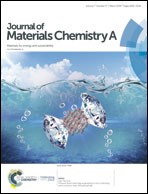Length evolution of fused-ring electron acceptors toward optimal blend morphology in polymer solar cells incorporating asymmetric benzodithiophene-based donors†
Abstract
Two new wide-bandgap polymers (PBDTBDD-Ph and PBDTBDD-PhPh) with different aggregation degrees and fused-ring electron acceptors (FREAs) (ITIC-4T, ITIC-3T and ITIC-2T) with different sizes were synthesized. The work was used to understand how to design the donor polymers and fused-ring electron acceptors (FREAs) for high-performance non-fullerene polymer solar cells (NF-PSCs). The results clearly demonstrated that weakly aggregated donor polymers and small-sized FREAs in appropriate degrees can match well with each other to achieve high power conversion efficiencies (PCEs). In other words, small-sized FREAs can be embedded more easily into the interspace of polymer chains and weakly aggregated polymers can offer larger space for the intercalation of FREAs. As a result, an NF-PSC device based on weakly aggregated polymer PBDTBDD-Ph and small-sized ITIC-3T yielded over 11% PCE. Thus, it would offer a feasible guideline to design high-performance NF-PSCs that meet the requirement of future industry-scale production.



 Please wait while we load your content...
Please wait while we load your content...